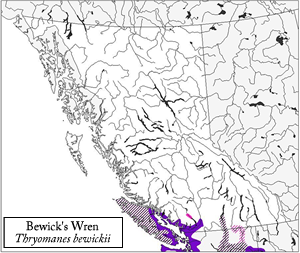The size, structure, plumage patterns, and behaviour of the Bewick’s Wren are all highly diagnostic, and it is unlikely to be confused with any other wren in the province.
| The male’s song is highly variable, including a variety of thin, rising buzzes and slow trills, although certain patterns dominate within the British Columbia portion of its range. The song usually begins with several short, sharp notes and ends with a long, high-pitched trill; typical variations include t-t zree drr-dree tututututututu and tick-r tick-r treeeeeeeeee. The introductory notes and overall cadence of the song are reminiscent of the song of a Song Sparrow, while the terminal trill may recall the song of a Spotted Towhee. Singing begins very early in this species, and populations on the south coast of B.C. are singing regularly by late January or February. Calls include a harsh, drawn-out shreee or jree-jree, a soft, dry jik, and a high, rising zrink. Source: Kennedy and White (1997); Sibley (2000) |
Courtship
Courtship and the formation of pair bonds occur very early in the year, usually in February or March. Pre-copulatory displays by the male include calling, mate-feeding, and spreading the tail and turning from side to side to expose the white spots in the outer tail feathers; the female may respond to these displays by wagging her tail back and forth or by giving soft calls. This species is primarily monogamous.
Nest
The nest is constructed by both sexes, with nest-building activities commencing as early as February or March in B.C. Most nests are constructed in 2-8 days, although poor weather may delay completion of the nest for up to 3 weeks. The nest is usually placed low to the ground, usually at a height of 1-2 m (occasionally as high as 10 m or as low as ground-level). The nest is a bulky cup that is typically placed in a cavity or on a sheltered shelf. This species is opportunistic in its choice of nesting substrates, and the location of nests is highly variable; nests occur in both natural (woodpecker cavities, hollows in snags, tree stumps, upturned tree roots, rock crevices) and artificial (buildings, barns, sheds, posts, abandoned automobiles, junk piles, nest boxes, brush piles) settings. The nest itself is constructed of a wide variety of materials such as dry grasses, twigs, wood chips, rootlets, moss, leaves, spider webs, feathers, wool, and hair and lined with finer materials; this species often incorporates whatever materials are available into its nest. The dimensions of the nest are somewhat dependent on the dimensions of the nesting chamber, but the cup of most nests is 5-6.5 cm across and 3.5-5 cm deep.
Eggs
This species appears to be double-brooded in B.C. The first clutch of (3) 5-7 (11) eggs is laid in late March or April and is incubated by the female for 14-16 days before hatching; a second clutch is sometimes laid in May or June. The smooth, slightly glossy eggs are white with very fine reddish-brown speckles and a few purplish-brown splotches (larger markings concentrated around the larger end of the egg). Eggs occur in B.C. from mid-March to mid-July. This species is a relatively uncommon host for Brown-headed Cowbird parasitism.
Young
The young are altricial and largely naked upon hatching, with pink skin and a few small patches of down. The young remain in the nest for 14-16 days before fledging, during which time they are tended by both parents. After fledging, the young remain together as a group and are fed by both parents for ~2 weeks before dispersing and becoming independent.
Source: Baicich and Harrison (1997); Campbell et al. (1997); Kennedy and White (1997)
|
This species usually forages low in shrubs and trees, commonly within dense vegetation and therefore difficult to observe (although it also forages regularly in exposed situations as well). It feeds on a wide variety of invertebrates, especially adult and larval insects and spiders, which it gleans from leaves, branches, and twigs or probes from crevices in the bark. It often forages on the ground, where it hops about and picks prey from the surface of the soil; it often flips fallen leaves aside to access the prey that is hidden underneath. It rarely hawks flying insects or captures prey by hover-gleaning. In suburban and rural areas, it is commonly attracted to bird feeders, especially where suet is offered.
Source: Kennedy and White (1997)
|
|

